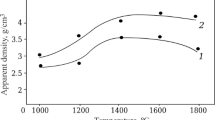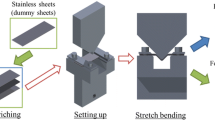Abstract
Modern methods of production of corundum fibers with a single-crystal and polycrystalline structure are subjected to a critical analysis. It is noted that single-crystal fibers are the most effective, but since they are obtained only under laboratory conditions their cost is very high. Four basic methods of production of polycrystalline corundum fibers are discussed. Some substantial disadvantages determining the low output and hence the high cost of the fibers are shown.
Similar content being viewed by others
References
I. G. Subochev, L. A. Dergaputskaya, I. V. Eremina, et al., “Analysis of the production and use of mullite-silica glass fiber refractories and prospects of raising their production at the Seversk dolomite works,”Ogneupoiy, No. 5, 33–36 (1992).
V. E. Matsera, “High-temperature fibers and their use for the production of composite materials,”Poroshk. Metall, No. 11, 13–16(1969).
L. Broutman and R. Crock (eds.),Modern Composite Materials, London (1967).
W. L. Lachman and I. P. Sterry,Ceram. Ind. Mag., No. 4, 120 (1965).
V. A. Karrol-Porchinskii,Materials of the Future [Russian translation], Khimiya, Moscow (1966).
W. W. Webb and W. D. Forgeng,J. Appl. Phys.,28(12), 1449 (1957).
M. M. Butcher and E. A. D. White, J. Am. Ceram. Soc.,48(9), 492(1965).
C. M. Hargreaves,J. Appl. Phys.,32(5), 936 (1961).
V. L. Balkevich,Technical Ceramics [in Russian], Stroiizdat, Moscow (1968).
L. A. Dergaputskaya, “Fabrication of polycrystalline fibers of aluminum oxide,”Ogneupory, No. 2, 26–29 (1983).
L. A. Dergaputskaya and L. N. Gaodu, “To the problem of fabrication of polycrystalline fibers of aluminum oxide,”Ogneupory, No. 8,39–41(1983).
Refractory Fibers from Aluminum Oxide. Express-Inform (Glass, Ceramics, and Refractories), Issue 10 [in Russian], VINITI, Moscow (1975).
Preparation of Refractory Oxide Fibers from Metal Alcoholates. Express-Inform. (Glass, Ceramics, and Refractories), Issue 26 [in Russian], VINITI, Moscow (1973).
Production of Fibers from Aluminum Oxide. Express-Inform. (Glass, Ceramics, and Refractories), Issue 25 [in Russian], VINITI, Moscow (1973).
W. C. Sleppy,J. Electrochem. Soc.,108, 1097 (1961).
I. N. Kalinovskaya and A. N. Gaodu,Highly Refractory Crystalline Fibers. Review Inform. (Ferrous Met. Sen 11), Issue 2 [in Russian], Chermetinformatsiya, Moscow (1977).
N. D. Nazarenko, V. M. Nechitailo, and N. I. Vlasko,Poroshk. Metall, No. 4, 10–12 (1964).
Author information
Authors and Affiliations
Additional information
Translated from Ogneupory i Tekhnicheskaya Keramika, No. 4, pp. 8–11, April, 2000.
Rights and permissions
About this article
Cite this article
Sokov, V.N. A new kind of corundum fibers and self-solidifying parts based on them. 1. Analysis of methods of production of corundum fibers and prospects of their development. Refract Ind Ceram 41, 119–121 (2000). https://doi.org/10.1007/BF02693767
Issue Date:
DOI: https://doi.org/10.1007/BF02693767




